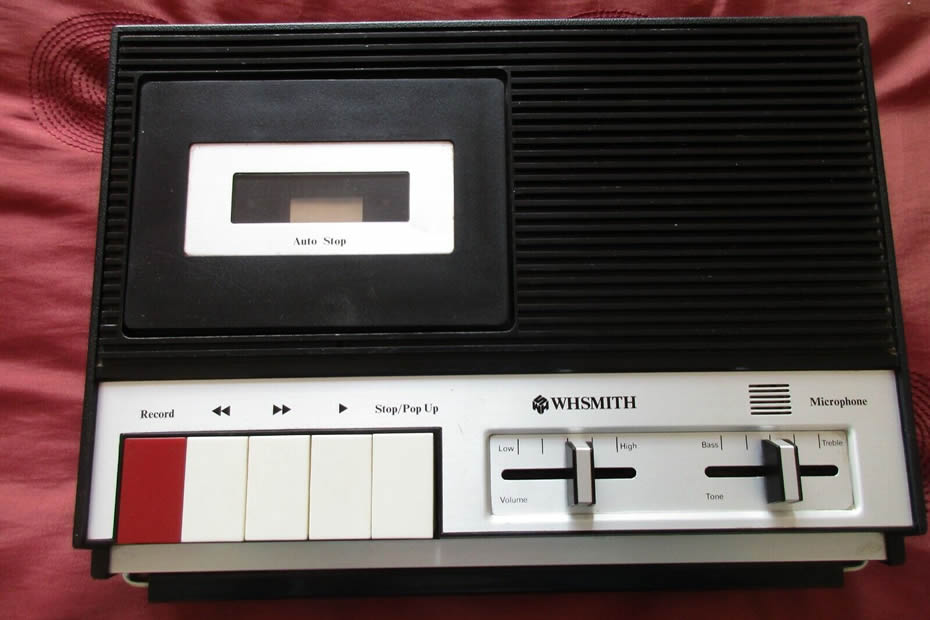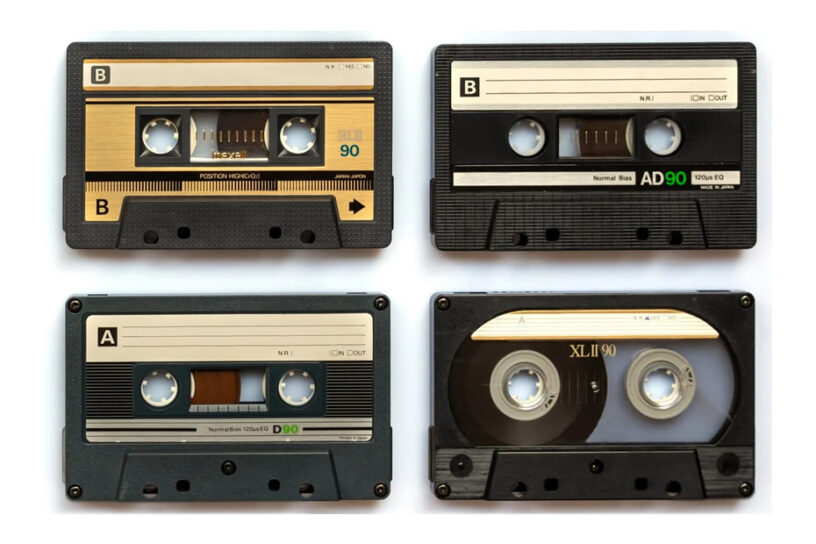Table of Contents:
Cassette tapes are supposed to be making a comeback (similar to vinyl), apparently.
Um… really?
1976 (ish)
Approximately 45 years (ish) ago, I had two choices if I wanted to listen to recorded music. I either played a record (now called “vinyl”), or I played a cassette tape. And that was it.
Sure, I could see bands on the TV, or I could go to a concert. But as there were no video recorders or camcorders in those days (that were available for the public to buy), if I wanted to listen to my favourite band, I either bought one of their albums (or singles) or I bought the cassette album.
I was lucky enough to own a cassette recorder (a W.H. Smiths mono portable cassette) and I was able to record my favourite chart hits from the radio, usefully facilitated by BBC Radio 1 presenting a Top 40 programme on Sundays.
The Top 40
Every Sunday, BBC Radio 1 would count the charts down in a two hour programme which was ideal for recording the tracks that I wanted (called “taping” in those days, as they were recorded to tape).
Then using my only playback device of choice, I could listen to my favourite hits at any time I wanted! Happy days.
Happy illegal days! It was 1976 when I started to do this – using a mono tape recorder and an FM radio. I didn’t do much of it, however. The only way I had to play the music back was through the W.H. Smiths mono cassette recorder that I had. It was portable, but it only had the built-in speaker or a single earpiece, so I only listened to it at home.
Enter Jean-Michel Jarre
When I started to go to College, I periodically used the bus service. It was approximately a 35-40 minute ride from home to college, and usually involved some hanging around at the college end waiting for the bus to appear in the Bus Station. Fortunately, the Bus Station had a number of small shops there – including a shop where they sold cassette tapes and records.
Now switch to the evening of Thursday 8th September 1977. Top of the Pops was on and played Jean-Michel Jarre’s Oxygene IV (danced to by Legs & Co.). I was so smitten by the track, that I went looking for it the next day in the Bus Station record shop.
There it was in that shop: the Jean-Michel Jarre album “Oxygene”. I snapped that up that very night and it became my very first bought commercial cassette album. (The album itself still remains my favourite album of all time, to this day.)
So there we were. I could play “Oxygene” (albeit in Mono), I had Top 40 hits (also in Mono).

Mono vs Stereo
Just before I continue, here’s a quick explanation of the difference between mono and stereo:
Mono or monoaural sound only uses one channel when converting a signal into a sound. Even if there are multiple speakers, the same signal will go to both speakers. This then gives the effect that the sounds, even if they are coming from separate speakers, are coming from one single position or source.
In today’s age of technology, most signals are more compatible with stereo, instead of mono sound, which was widely used for radio broadcasts in the past – and earlier cassette recorders like mine.
Contrary to mono sound, stereo sound uses more than one channel when converting a signal into a sound. This essentially means that each signal sent out is unique. For example, when a song sends different sounds to the left earbud versus the right, like in the classic song “Bohemian Rhapsody”, it requires and is best used with stereo sound.
Stereo sound, then, gives the effect of sound coming from different sources and positions, which is typical and very common in today’s technology, especially in speakers that are produced for the ‘surround sound’ effect.
Stereo arrives!
By 1977, stereo equipment had been around for a long time. My Dad had hi-fi separates, which included a stereo tape cassette deck, amplifier and record player. I had none of these (and couldn’t afford them), so I had to make do with my W.H. Smiths mono cassette recorder. Until boomboxes came out.
Boom!
Boomboxes (or ghetto blasters) had been around since the late 1970’s but I couldn’t afford one until roughly 1982\1983. I bought a boombox (unfortunately, I can’t remember what make and model it was!) but I do remember it being very big (negating the portable aspect of it – it weighed a ton!!). The point was that I could now record good quality stereo recording from FM radio and play then back. In stereo.
It was at this point that I started to regularly record tracks from the Top 40 on Radio 1 (and other radio stations, as commercial radio had just started in the UK – and we had a local radio station). From 1983 to around 1987, I filled up quite a few 90m cassettes with music and bought quite a few cassette albums.
It was also around this point (mid 1980’s) that Sony launched a portable player for those new-fangled CD’s that had appeared on the market.
Hello CD, you beautiful thing, you!
When CD albums were first released, it was amazing! Digital quality music – and lots of it – on one CD. No longer constrained to 20 minutes per side of a tape cassette or record, a single CD would hold up to 80 minutes on it. All in beautiful digital goodness, with no crackling (records) or background hiss (tapes). They were robust enough to carry around for years (if treated with a modicum of respect – they weren’t indestructible!) and they sounded perfect.
They turned out to be just as versatile as tapes, but without the noise. You could record on them (CD-R), re-record on them (CD-RW) and make disc-to-disc (illegal) copies (with the *cough* right software). Initially expensive, they got cheaper and cheaper as time went on.
And so at that was the end of cassette tapes for me. I packed them up in some tape cases and put them in the loft. Threw away my boomboxes and Walkmans and got on with my Discmans!
Then digital music arrived in the form of mp3, FLAC, wav and all manner of formats.
Digital Music
Very briefly: digital media is now everywhere and accessible to anyone with a digital device. Apple Music, Amazon, Spotify – there are many ways to listen to digital media nowadays on a plethora of digital devices. All in top quality digital pop-free hiss-free quality.
Why’s the old shit coming back if it’s that bad?
One of my favourite YouTube channels is a chap called Matt, who is the proprietor of the channel “Techmoan”. He is a chap (similar to me) who likes the old “retro” cassette and record players amongst many other “vintage” and odd memorabilia.
He once did a video about the Sony Walkman WM-DC6 – a professional grade Walkman that was amongst the top Walkmans at the time it was produced. As I recall. he did say that it was one of the favourite Walkmans that he owned (he owns a lot!), but they do fetch a lot of money on places like eBay (and they aren’t necessarily in brilliant condition).
I thought about it for a long time, then dragged down my cassette collection that had been hanging around in the loft for the last 30 years. Sadly, some water damage had occurred rendering about 10% of it bin-able, but the greater majority were saved. So I bought a Walkman and proceed to play my tapes.
You know what? 30 years later, some of them (but very few) sound as good as they did when I bought them (remember – they didn’t sound good when they were brand new!). Some of them have suffered the 30 years of storage though – they have “echoes” (where the tape’s been sat in the same position for 30 years and the magnetic particles have all lined up) some have snapped (a frequent problem when a tape was played a lot) and some have suffered from rot or warpage as the plastic tape has heated up and cooled down. All of which culminates in a terrible listening experience.
But I bought a Sony Walkman WM-DC6 anyway (it was a lot of money – but I’m OK with that) and proceed to play my tapes. And yep, they’re still far, far worse sounding than CD, but it was great fun listening to all the 80’s music, complete with hiss, pops and echoes.
So…
I can understand the nostalgia element of being able to listen to music recorded over 30 years ago. I can also understand the “displayability” of the tape cassette cases being lined up in a lovely wooden display case. Yes, it’s nice to listen to them again, but it’ll be a one-off. I’ll never record anything on a tape again – why would you with smartphones and digital recorders?
This where things get strange in the modern world.
I could understand if you were someone like me; that lived through that whole tape experience in the 1970’s and 1980’s wanting to re-live it for a while – just for nostalgia purposes. But given that the greater majority of music has now been digitised anyway, I don’t understand why someone from a later generation would even want to listen to a tape (or a record) at all. Or even know what they were.
Strange people.

